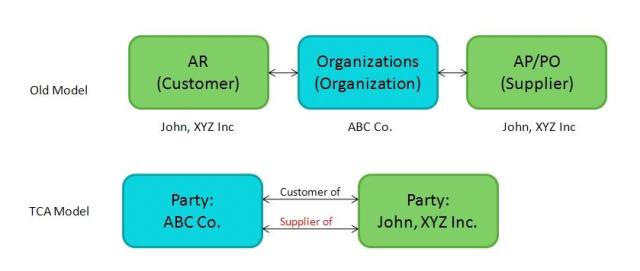What is TCA?
- Oracle Trading Community Architecture (TCA) is a data model that allows you to manage complex information about the parties, or customers.
- Trading Community Architecture is the implementation of technology and applications to allow users to create and maintain relationships among entities. It is a way to understand who your customer interacts with inside and outside the enterprise.

Note: Customer, Vendor, Supplier are the terms that we come across very frequently.
For instance: We buy goods from a Shop Vendor so we are the Customer to that Vendor and the Vendor is our Supplier for that good. The Vendor gets goods from a merchant who actually produces it (Manufacturer), so now the vendor in-turn becomes a customer to the Manufacturer who is the Supplier.
The complete TCA can be related and runs around all these terms, these may be people we meet generally who might be a Supplier or Customer in our perspective.
Now moving ahead lets go in details about TCA.
How TCA Matters?
Before TCA:
- There are multiple customer definitions across the enterprise.
- It was very difficult to track current and historical information about the customers.
- There was a lack of support for mixed business.
- It was quite tough to understand relationships between customers and others (suppliers, partners, competitors)
- Create a central repository for the entire E-Business Suite to store information relating to all members of a trading community versus separate tables for each member-Prospects, Customers, Contacts, Employees, Partners, Distributors, Suppliers, Banks, etc.
- Record complex business relationships between Trading Community entities (including 3rd party relationships).
- Support all business models, industries, and geographies.

| TCA Data Model Components: | |
| Party | Represents any entity that can enter into business relationships with your organization – Organization, Person, or Group |
| Party Relationship | A binary relationship between two parties such as a partnership. Example: Adam is a specific person party and Eve Inc. is an organization party. Adam at Eve Inc. is also treated as a party with the type relationship |
| Location | A Street Address |
| Party Site | Associates a party with a location, indicating that party’s usage of the location |
| Contact | A person related to an organization, this can be a relationship between an organization and a person as well as between two people |
| Contact Point | Your avenue of contacting a party i.e. a phone number ,e-mail address or fax number |
| Customer Account | Represents a customer relationship between your organization and a party |
| Customer Account Site | A party Site that you use in relation to a customer account, i.e, a bill-to or ship-to address |
| Customer Account Contacts | A party contact that is used as a means of contacting the customer regarding his/her account |
TCA in 11i
- 11i TCA already equipped to handle the following entities
–>Customer
–>Employee
–>Student
Here is Summarize information of the tables Pre and Post 11i:TCA in R12 Includes:
- New trading entities
–>Suppliers
–>Banks & Bank Branches
–>Legal Entity
TCA Data Model : Supplier & Customer
TCA in R12: Supplier Representation
- Supplier organizations are in TCA
- Terms of doing business with the supplier are in Purchasing / Payables
- Supplier organization, address, contact, phone, email etc. are all in TCA
- Employees are already in TCA, Payables using the same employee records in TCA
TCA in R12: Supplier Data Mapping
TCA in R12: Bank Account Model

TCA in R12: Bank Model
New Bank Account Model
- Central place to define internal bank accounts
–>Keep track of all bank accounts in one place
–>Explicitly grant account access to multiple operating units/functions and users
- Multi-Org Access
–>In the new model, bank accounts are
owned by Legal Entities with the option to grant account use to
Operating Unit (Payables, Receivables), Legal Entity (Treasury),
Business Group (Payroll) .
R12 Multi-org access control
- MOAC is new enhancement to Multiple Organization feature of Oracle Application
- Enables Users to access the data from one or many Operating Units within a set of given responsibility
- Data Security is maintained using Multiple Organization Security Profile, Define in Oracle HRMS.
Three key CE tables now as
1. CE_BANK_ACCOUNTS
–>Stores bank account attributes
2. CE_BANK_ACCT_USES_ALL
–>Stores the bank account use attributes specific to Operating Unit (AR, AP) and Legal Entity (Treasury).
3.CE_GL_ACCOUNTS_CCID
–>Accounting data pertaining to the bank account use
- All of the bank, branch and bank account related attributes in AP_BANK_BRANCHES and AP_BANK_ACCOUNTS_ALL tables will be upgraded to HZ_PARTIES and the new tables in Cash Management.
–> Release 12, what’s New:
TCA Bank Model in 11i and R12:

TCA in R12: Legal Entities
- Legal entity is created as a party of party type ORGANIZATION or PERSON
- An establishment is created as a party of party type ORGANIZATION.
- TCA creates a new classification category called “Business Function”. It is used mainly to model what business functions a party can perform in E-Business Suite
- For modeling legal entities and establishments in TCA, classification code “Legal Entity” and “Establishment” are created under the “Business Function” class category.
- An establishment is created as a party and always link to a party that is classified as a legal entity through the relationship model
- The Trading Community Manager Responsibility, allows users to create a setup or update data sharing and security
- Customer Standard form that has been existing till R11i is finally gone.
- Oracle Introduced a brand new HTML UI built using OA Frame works
leveraging TCA that can be used to manage Customers, Accounts, etc.
TCA API’s List:
No comments:
Post a Comment